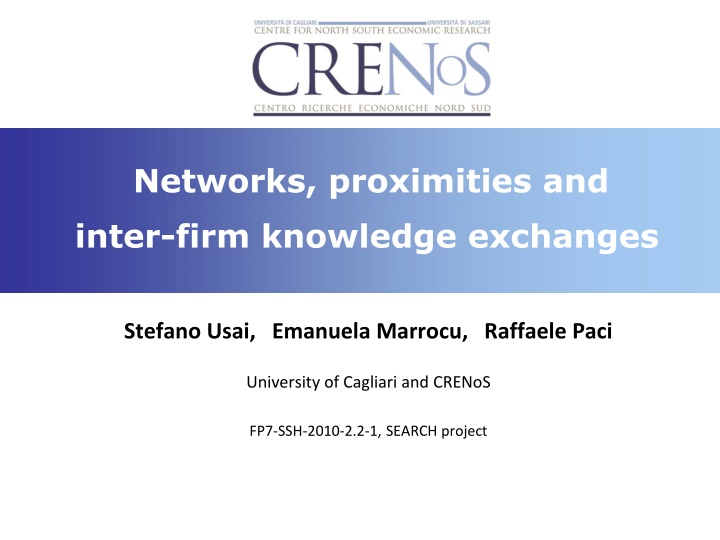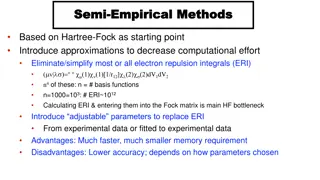
Inter-Firm Knowledge Exchanges in Networks and Proximities
Explore the dynamics of inter-firm knowledge exchanges within various networks and proximities, highlighting the role of spatial, technological, social, and organizational proximities. Discover how inter-firm agreements facilitate knowledge sharing and enhance innovation, drawing insights from studies on knowledge flows through research programs, co-patenting, citations, co-publications, and human capital mobility.
Uploaded on | 2 Views
Download Presentation

Please find below an Image/Link to download the presentation.
The content on the website is provided AS IS for your information and personal use only. It may not be sold, licensed, or shared on other websites without obtaining consent from the author. If you encounter any issues during the download, it is possible that the publisher has removed the file from their server.
You are allowed to download the files provided on this website for personal or commercial use, subject to the condition that they are used lawfully. All files are the property of their respective owners.
The content on the website is provided AS IS for your information and personal use only. It may not be sold, licensed, or shared on other websites without obtaining consent from the author.
E N D
Presentation Transcript
Networks, proximities and inter-firm knowledge exchanges Stefano Usai, Emanuela Marrocu, Raffaele Paci University of Cagliari and CRENoS FP7-SSH-2010-2.2-1, SEARCH project
Motivation / 1 Knowledge, one of the most relevant intangible assets, is a crucial determinant of innovation and economic performance. The creation and acquisition of knowledge is fundamental for economic and social enhancements. The exchange of knowledge among agents is facilitated by their spatial proximity given its well known tacit nature, which usually bounds the spatial scope of spillovers. However, the concept of proximity has several other dimensions which may have an a-spatial nature. This is the case for technological, social, institutional and organisational proximity. Moreover, economic agents may establish social links within different networks that may facilitate the exchanges of knowledge and moderate the adverse effects of distance. The literature has extensively analysed the features of these networks and their effects on knowledge diffusion considering various forms of connections among agents (co-inventorship, research collaborations, patent citations)
Motivation / 2 In this paper we follow a novel route by looking at the knowledge exchanges which are due to inter-firms agreements (joint ventures and strategic alliances). According to the management literature (Kogut 1988; Inkpen 2000; Oxley- Sampson 2004) inter-firm agreements, whatever their specific nature and motivation, create the conditions for knowledge sharing and thus represent an important channel of knowledge transmission. Firms perform several activities before, during and after the agreements, which allow partners to access and share knowledge-based resources often embedded within the organisations (Muthusamy-White 2005; Janowicz -Noorderhaven 2008; Garc a-Canal et al. 2008). These flows may include access to new technologies and organizational competencies or integration, sharing and transfers of capabilities and human and organizational resources, or formal and informal inter- organizational learning processes.
Empirics on knowledge flows / 1 Studies based on various indicators of knowledge exchanges among agents and territories: Participation in research programmes (Autant-Bernard et al., 2007; Maggioni et al., 2007; Balland 2012) Co-patenting (Cantner and Meder, 2007; Maggioni et al., 2007, Picci, 2010; Cassi and Plunket, 2012) Citations (Paci and Usai, 2009) Co-publications (Ponds et al., 2007) Applicant-inventors relationships (Maggioni et al., 2011) Human capital mobility (Miguelez-Moreno, 2011 and Breschi and Lissoni, 2009).
Empirics on knowledge flows / 2 Studies based on inter-firm agreements / cooperation used as indicators of knowledge exchange, but limited to a single industry: footwear (Boschma and Ter Wal, 2007) nanotechnology (Autant Bernard et al., 2007) aviation (Boschma and Broekel, 2009) biotechnology (Fornahl et al., 2011) global navigation satellite system (Balland, 2012) genomics (Cassi and Plunket, 2012) Other studies give a global picture of the role of proximities but with aggregated regional data (Paci et al., 2014; Maggioni et al., 2012).
Aim Analyse how inter-firm collaborations, and the consequent knowledge exchanges among partners, are affected by the features of the networks in which firms are involved and by the proximity (measured with respect to different dimensions) among participants. Estimate the likelihood that two organizations engage in a partnership as a function of their relative geographical, technological, social, organizational and institutional proximity and their positioning within the network (degree and closeness centrality).
Our contribution We investigate announced agreements (domestic and international) with at least one firm localised in Italy over the period 2005-2012. Agreements covers all economic activities and this allows us to offer a wide-ranging scenario with respect to previous contributions on the role of proximity. We consider 631 agreements which involve 1078 firms giving rise to 887 pairs. We consider the concurrent effects of five proximity dimensions and two network features. The general traits of the agreements involving Italian firms are very similar to other national or international contexts: firms propensity to start an agreement depends much more on sectoral features rather than on country differences (Narula & Hagedoorn 1999).
Dataset / 1 Inter-firm agreements with at least an Italian participant, 2005-2012 Announced agreements with 2 participants with 3 participants with 4 participants with 5 participants with 6 participants with 7 participants 631 570 43 90% 7% 6 8 2 2 1% 1% 0% 0% Participant pairs joint ventures strategic alliances 887 607 68% 280 32% Participants Italian foreign 1078 511 567 47% 53% completed uncompleted 382 43% 505 57% with both partners in Italy with one partner in Italy with both partners not in Italy 121 130 636 15% 72% 14%
Dataset / 2 Participants per country of origin, 2005-2012 Number % Italy EU countries United States India China Russian Fed. Utd Arab Em. Canada Turkey Japan 511 141 127 72 44 40 16 13 13 11 47.4 13.1 11.8 6.7 4.1 3.7 1.5 1.2 1.2 1.0 Rest of the World 90 8.3 Total 1078 100.0
Dataset / 3 Agreements and participants per SIC division, 2005-2012 Agreements Participants Num. % Num. % A Agriculture B Mining C Construction D Manufacturing E Transp., Comm., Energy, Sanitary Serv. F Wholesale Trade G Retail Trade H Finance, Insurance, Real Estate I Services (personal and business) J Public Administration 1 0.2 3.2 1.6 46.8 14.8 2.4 2.4 15.1 12.6 0.9 2 0.2 3.2 1.9 33.8 14.4 9.2 4.8 14.3 18.1 0.3 20 12 213 91 58 30 90 114 34 17 504 160 26 26 163 136 10 2 Total 631 100.0 1078 100.0
Dataset/4 The network is technically an affiliation network (or a two mode network) since each partnership is a sort of subnetwork among partners We are not going to exploit too much this characteristic The network is quite large, it is symmetric, it has a low density (0.0015) and it is not completely connected, that is not all actors can reach all other actors
Basics of Social Network Analysis/0 Density is given by the proportion of all possible ties that are actually present - Sum of existing ties divided by the number of all possible ties Density informs about the speed at which information or resources diffuse among the nodes and the extent to which actors have high levels of social capital and/or social constraint Density=18/(6*5)=18/30=.6 Density=1
Empirical model / 1 Prob (agreementij) = f (proximitiesij, networki, networkj, controlsi, controlsj) The observational units are pairs of firms (ij) The dependent variable is a binary variable: = 1 for firm pairs (887) which actually established a link = 0 for firm pairs that could have set up an agreement but did not. The zero observations are potential pairs. They are computed by pairing all the firms (1078) included in our sample (580,503) and subtracting the actual pairs (887). The potential pairs are 579,616. Setting up a cooperative agreement is a rare event (0.15% of realizations). In this case the logit model estimated on the total number of firm pairs severely underestimate the probability of occurrences. Therefore the analysis is performed within a logistic framework for rare events (King and Zeng, 2001, 2002).
Empirical model / 2 Prob (agreementij) = f (proximitiesij, networki, networkj, controlsi, controlsj) Explanatory variables Proximity dimensions between any two firms - Geographical - Technological - Organizational - Institutional - Social Network structure of each firm - degree centrality - closeness centrality Firm controls status (listed, private), organization (independent, in a group), ownership nationality, geographical location (North-Centre-South of Italy, EU), main sector of activity (10 SIC divisions)
Geographical proximity The diffusion and absorption of external knowledge, especially in its tacit component, is facilitated when agents are physically proximate (Von Hippel, 1994). Consequently, spatial proximity has been the most thoroughly investigated dimension within the wide literature on localised knowledge spillovers and flows (Jaffe et al., 1993; Jaffe, 1995; Anselin et al., 1997). As a measure of geographical proximity we use the inverse of the distance in kilometers between the location of the partners. Alternative measure: dummy variable which takes value 1 when both partners are located in the same Italian region.
Technological proximity Knowledge transfer require a homogenous cognitive base to understand, process and absorb the external available knowledge (Cohen and Levinthal, 1990). Firms that share a similar knowledge base can exchange knowledge more easily and efficiently. We compute a set of five mutually exclusive technological interaction dummies, ordered by decreasing technological similarity (Ellwanger and Boschma, 2012) and based on the Standard Industrial Classification: ID_intra_SIC4 = 1 when the partners operate in the same 4-digit SIC Industry and 0 otherwise; ID_intra_SIC3 = 1 when the lowest degree of industrial relatedness is the 3-digit SIC Industry Group; 0 otherwise (i.e. they operate in different Industry group or are related at a lower industrial disaggregation); with the same methodology we compute the dummies ID_intra_SIC2 for the 2-digit SIC Major group and ID_intra_SIC1 for the 1-digit SIC Division; ID_inter_SIC1 = 1 when the partners operate in different divisions (conglomerate agreements); this set of firms is the reference group.
Standard Industrial Classification The Standard Industrial Classification SIC is a system for classifying industries by a four-digit code. Established in the United States in 1937, it is used by government agencies to classify industry areas. The SIC system is also used by agencies in other countries, e.g., by the United Kingdom's Companies House. In the United States the SIC code is being supplanted by the six- digit North American Industry Classification System (NAICS code), which was released in 1997; however certain government departments and agencies, such as the U.S. Securities and Exchange Commission (SEC), still use the SIC codes. The SIC codes can be grouped into progressively broader industry classifications: industry group, major group, and division. The first 3 digits of the SIC code indicate the industry group, and the first two digits indicate the major group. Each division encompasses a range of SIC codes
Range of SIC Codes Division 0100-0999 Agriculture, Forestry and Fishing 1000-1499 Mining 1500-1799 Construction 1800-1999 not used 2000-3999 Manufacturing Transportation, Communications, Electric, Gas and Sanitary service 4000-4999 5000-5199 Wholesale Trade 5200-5999 Retail Trade 6000-6799 Finance, Insurance and Real Estate 7000-8999 Services 9100-9729 Public Administration 9900-9999 Nonclassifiable
Organizational proximity The exchange of information and knowledge can be influenced by the membership of individuals to the same club, group or organisation. The common membership implies the sharing of a set of rules and practices, based on organizational arrangements, which are crucial in reducing uncertainty and opportunistic behaviour (Kirat and Lung, 1999). Such arrangements can be either within or among firms and may take different forms along a range which goes from informal relations among companies to formally organized firms. We measure organizational proximity with a dummy (ID_intra_group) equal to 1 if the two organizations involved in a partnership belong to the same corporate group (i.e. they have the same ultimate parent company), as in Balland et al. (2013).
Institutional proximity The exchange of knowledge among economic agents is facilitated if they share the same institutional framework (such as laws and norms) since it provides them a set of common procedures and routines. This common background may be crucial in reducing uncertainty, lowering transaction costs, favouring a pro-cooperative attitude, which enhances the possibility of agreements and the knowledge exchanges (Maskell and Malmberg, 1999; Gertler, 2003). We measure institutional proximity with a dummy (ID_status), which takes value 1 if the two firms share the same status (both listed or private, or government). Alternative measure: dummy (ID_indep), which takes value 1 if the partners are both independent entities.
Social proximity Direct and indirect relationships in the past provide a facilitating environment for sharing knowledge in the future. Thus the degree of social proximity decreases with the geodesic distance measured by the shortest path between two nodes (i.e. firms) (Autant-Bernard et al., 2007; Balland, 2012). As indicator of social proximity we use the inverse of the geodesic distance, which ranges from zero (when two nodes have infinite distance, neither they nor any of their direct and indirect partners ever met in the past) to one (when two nodes are directly linked). In order to retrieve as much information as possible from our data we compute: the inverse of the recursive measure of geodesic distance (geod_dist_rec) between firm i and firm j in all previous years available. alternatively: the inverse of the geodesic distance only in the previous five years (geod_dist_5y).
Basics of Social Network Analysis/1 Direct linkage: 1 and 2; 2 and 3 Indirect linkage: 1 and 3; 1 and 5; 2 and 6 Shortest distance: Equal to 1 when direct linkage Greater than one when indirect linkages, that is equal to 2 btwn 1 and 3; equal to 3 btwn 1 and 5 Equal to infinity when there is no linkage: 1 and 5; 2 and 6
Network characteristics Knowledge flows across a-spatial networks, where agents exchange ideas on a voluntary base (Cowan and Jonard, 2004) according to the characteristics of the network. The most salient ones are: preferential attachment: actors tend to link to the most connected individuals; agents with a large number of relations are more attractive because they are supposed to be more productive or more trustworthy (Barabasi and Albert, 1999) Indicator: degree centrality, based on the number of links (relations) of each firm in the previous period 2000-2004. transitivity (reachability): some nodes are relatively closer to all other nodes and therefore they are a more effective way to potentially connect to all other nodes in order to acquire knowledge. Indicator: closeness centrality, based on the inverse of the sum of the distances of a node to all other nodes in the previous period 2000-2004. (this amount to measure how long it will take to spread information from one node to all other nodes sequentially).
Basics of Social Network Analysis/2 Degree centrality Node 1 has a degree centrality of 2 Node 3 has degree centrality of 4 Closeness centrality Node 1 has a closeness centrality of 1/14 Node 3 has closeness centrality of 1/8
Estimation method / 1 The analysis is performed within a logistic framework for rare events (King and Zeng 2001, 2002), the standard logistic approach would underestimate the probability of occurrences because of the large number of zeros. We apply the endogenous stratified sampling approach which requires selecting all the observations for which Y=1 (the cases ) and randomly selecting the observations for which Y=0 ( controls ). We sequentially consider several samples sizes by increasing the number of zero observations. We stop when we get no further improvements in terms of estimates accuracy. We select the 0.1 proportion (1/10: each actual pair matched with 10 other randomly drawn potential pairs) Number of observations: 887+8870 = 9757
Estimation method / 2 /2 Estimation is based on the prior correction method, which corrects for the bias induced by selecting with respect to the response variable. The correction is based on the population proportion of one observations (0.0015 that is 0,15%). Similar results when we apply the alternative correction method, based on weighting.
Estimation strategy The starting point is that the random probability of an agreement is 0.15% (out of all potential pairs). Estimate the benchmark model with just geographical proximity, network characteristics of each partner and firm controls. 1. Estimate dimensions: technological, organisational, institutional and social. the baseline model with all additional proximity 2. Test for robustness with respect to alternative proximity measures and subsamples. 3. Post-estimation stage: measure the increase in the estimated conditional probability for a given change in each variable in turn to assess the effects of proximity or network features on the likelihood that any two firms exchange knowledge. 4.
Logit models - prior correction for rare events standard baseline robustness Obs: 9757 All firms controls included Random probability of an agreement = 0.15% 1.495 *** Spatial proximity geographic distance (inverse) 0.254 *** 0.256 *** 0.257 *** 0.254 *** same region Technological proximity same division (SIC1) Preferred model with five proximity measures, network effects and individual controls: all dimensions of proximity exhibit a positive and significant effect. 0.939 *** 2.733 *** 3.174 *** 3.972 *** 0.931 *** 2.720 *** 3.123 *** 3.984 *** They are complementary and not substitute. 0.939 *** 2.732 *** 3.167 *** 3.969 *** 0.945 *** 2.731 *** 3.209 *** 3.966 *** same major group (SIC2) same industry group (SIC3) same industry (SIC4) Organisational proximity same group 3.279 *** Inter firm agreements are mostly facilitated by a common cognitive base 3.073 *** 3.128 *** 3.046 *** Institutional proximity same status 0.199 ** 0.208 ** Preferential attachment and transitivity are both network features which positively affect the probability of a knowledge exchange. 0.223 ** both partners independent 0.205 Social proximity geodesic distance (inverse) 0.175 *** 0.169 *** 0.178 *** geodesic distance (inverse, 5 years) 0.120 * The concurrent effect of 5 proximities and 2 network features makes the probability of inter firm agreements increase up to 3.8%, which is 25 time higher than the basic random probability (0.15%) Network effects degree centrality - partner 1 0.076 *** 0.065 *** 9.117 12.705 * 0.068 *** 0.063 *** 13.453 ** 17.127 ** 0.069 *** 0.064 *** 14.362 ** 17.695 ** 0.068 *** 0.063 *** 13.330 ** 16.928 ** 0.069 *** 0.065 *** 13.661 ** 17.732 ** degree centrality - partner 2 closeness centrality - partner 1 closeness centrality - partner 2 Estimated prob. at median values 0.027 0.038 0.028 0.031 0.039
Logit models - robustness standard baseline robustness Obs: 9757 Spatial proximity geographic distance (inverse) 0.254 *** 0.256 *** 0.257 *** 0.254 *** All firms controls included same region 1.495 *** Technological proximity same division (SIC1) 0.939 *** 2.733 *** 3.174 *** 3.972 *** 0.931 *** 2.720 *** 3.123 *** 3.984 *** 0.939 *** 2.732 *** 3.167 *** 3.969 *** 0.945 *** 2.731 *** 3.209 *** 3.966 *** same major group (SIC2) same industry group (SIC3) same industry (SIC4) Organisational proximity same group 3.073 *** 3.279 *** 3.128 *** 3.046 *** Institutional proximity same status 0.199 ** 0.208 ** 0.223 ** both partners independent 0.205 Social proximity geodesic distance (inverse) 0.175 *** 0.169 *** 0.178 *** geodesic distance (inverse, 5 years) 0.120 * Network effects degree centrality - partner 1 0.076 *** 0.065 *** 9.117 12.705 * 0.068 *** 0.063 *** 13.453 ** 17.127 ** 0.069 *** 0.064 *** 14.362 ** 17.695 ** 0.068 *** 0.063 *** 13.330 ** 16.928 ** 0.069 *** 0.065 *** 13.661 ** 17.732 ** degree centrality - partner 2 closeness centrality - partner 1 closeness centrality - partner 2 Estimated prob. at median values 0.027 0.038 0.028 0.031 0.039
Estimates for sub-samples We have carried out a sub-sample analysis to investigate whether relevant differences emerged when splitting the sample according to some features of the knowledge flows: completed vs. uncompleted agreements joint ventures vs. strategic alliances manufacturing vs. service sectors This analysis is rather preliminary since the limited number of actual agreements prevents us from estimating all the sub-samples and thus further research is required. In any case, no significant differences were found across subsamples, thus confirming the main findings discussed above for the whole estimation sample.
Effects of Proximities and Networks on the probability of Inter-Firms Agreements From Model 2 Table 4: Prob (Y=1|X)=0.03765 Standard deviation difference Absolute Percentage All changes are equal to one standard deviation and are measured with respect to the median Increase Spatial proximity geographic distance (inverse) 3321.71 0.00870 23.11 Technological proximity same division (SIC1) same major group (SIC2) same industry group (SIC3) same industry (SIC4) 0.424 0.168 0.122 0.184 0.01730 0.02036 0.01670 0.03706 45.95 54.08 44.36 98.43 Organisational proximity same group 0.039 0.00459 12.19 Institutional proximity same status 0.470 0.00351 9.32 Social proximity geodesic distance (inverse) 0.036 0.00032 0.85 Network effects degree centrality (partners average) closeness centrality (partners average) 4.353 0.005 0.01172 0.00306 31.12 8.13
Main results and conclusions The results of our preferred model with five proximity measures, network effects and individual controls show that all dimensions of proximity exhibit a positive and significant effect. They are complementary and not substitute. Knowledge exchanges are facilitated not only by spatial proximity, but most importantly by a common cognitive base (impact is five times higher). Preferential attachment and transitivity are both network features which positively affect the probability of a knowledge exchange. The concurrent effect of the five proximity dimensions and of the two network features makes the probability of knowledge exchanges increase up to 3.8%, which is 25 time higher than the basic random probability (0.15%).
Policy implications /1 The existence of several channels of firms knowledge exchange calls for a coordinated strategy able to achieve different targets with diverse instruments. More policies should aim directly to knowledge diffusion and absorption taking into account the diverse institutional and industrial contexts: no one size fits all policies (Todling and Trippl, 2005; Asheim et al, 2011). Practically, policies should support formation of dense networks among firms which go beyond geographical clusters and which may exploit very diverse channels for knowledge flows. and encourage the
Policy implication /2 Technological geographical one in influencing inter-firm agreements and thus knowledge exchanges. This suggests the implementation of specific industrial policies to support the formation and the functioning of a-spatial industrial clusters characterized by proximate technology. proximity matter much more than the Finally, the presence of externalities which exploit social interregional relations requires policies designed specifically to provide a balanced set of incentives to motivate economic agents towards cooperation competitiveness. without deterring
Future research actually current revision based on referees comments Consider more complex measures of technological relatedness and firms industrial characteristics Consider other measures of firms network positioning: betweenness Consider other measures of firms geographical positioning: regions Consider other measures of social and institutional proximity at regional level Robustness test with other countries Robustness test with respect to other forms of internationalisation: M&A or greenfield investment Post-deal performance analysis with a more inter-temporal perspective Robustness test with other forms of agreements and cooperation
Basics of Social Network Analysis/2 plus Betweenness centrality is based on the number of shortest paths from all vertices to all others that pass through that node. Betweenness centrality is a more useful measure (than just degree) of both the load and importance of a node. Betweeness centrality Node 1 has a betweeness centrality of 1 Node 3 has betweeness centrality of 9










